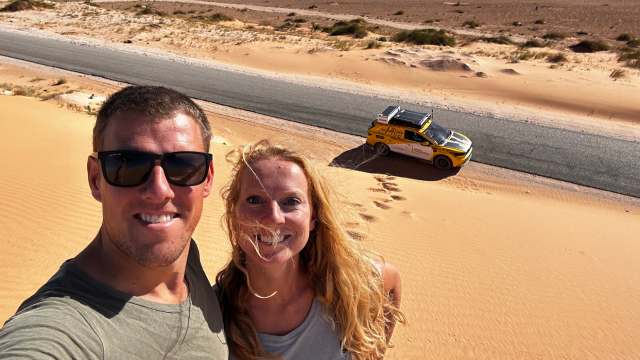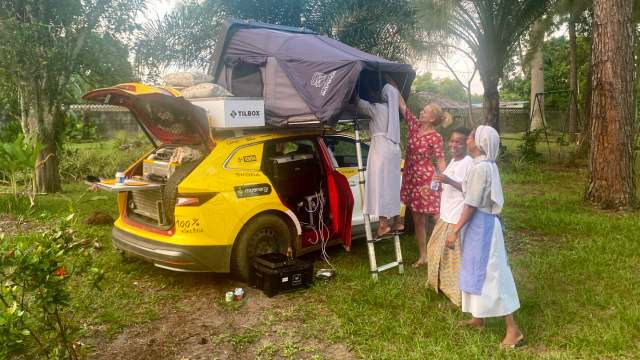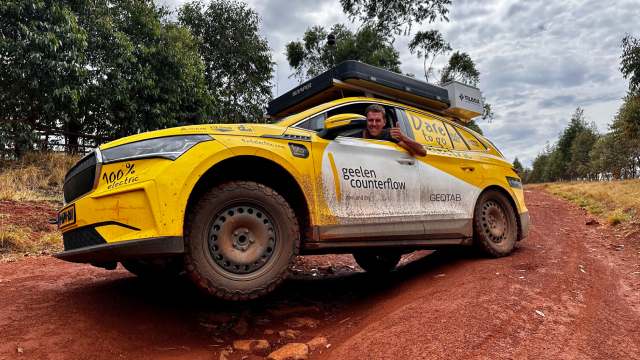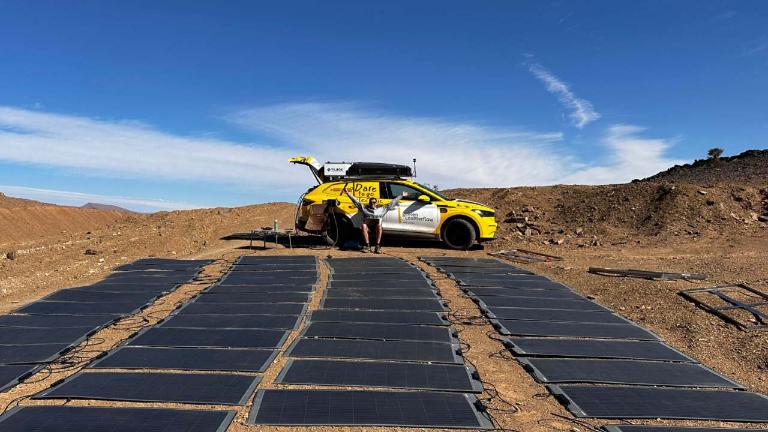From Netherlands to South Africa, an all-electric adventure with Škoda Enyaq iV
Show what’s possible when driving electric on an adventure trip through Africa, charging Škoda Enyaq iV mostly with solar panels: this is the mission being experienced by Renske Cox and Maarten van Pel.
Renske Cox and Maarten van Pel are a couple of adventure travel enthusiasts, so much that they decided to take on an expedition to Africa for the first time in a Škoda Enyaq iV: "We wanted to try a sustainable way of traveling, inspiring others in this regard as well when it comes to travel. Sustainability is often seen as something that is necessary, not fun and difficult to put into practice. We want to try to change this approach, making it fun and accessible for more people. We chose the Škoda Enyaq iV because it is a perfect car for families, which makes our expedition more approachable for others, plus it is also efficient and big enough to store all the equipment we need for our adventure", Renske says.

From theory to practice
The car was set up specifically for this expedition by a non-governmental non-profit organization (there is no form of profit), and the expedition itself was supported by some 30 partner companies. The idea was born thinking about going around the world in a sustainable way, excluding the use of airplanes to reduce the carbon footprint. After an initial experience aboard an electric car, the choice was immediate.
"We started studying the details with a positive push that came from friends and family. Since we wanted to be self-sufficient, the idea of charging the car with solar power was born. We calculated that in order to drive across Africa for a year, we would have needed an energy peak of 10 kW for charging. Subsequent assessments involved the space needed inside and outside the car, with the rooftop tent", Maarten adds.

Toward the expedition
The most complicated aspect was finding partners to support the expedition. Few companies believed in this venture, so Renske and Maarten decided to personally buy their Škoda Enyaq iV 80. At this point, the Dutch car dealership Van den Brug and Campwerk became the first sponsor of the expedition, providing the rooftop tent. Gradually, other partners stepped up: Venema E-mobility provided 60 m² of solar panels and Tilbox the rooftop box, which serves as a container for the 60 m² of solar panels.
"After our main partner Geelen Counterflow joined the expedition, we started rebuilding the car: almost everything in the back had to be removed. Then we installed custom Cobra Suspension springs, which were needed to lift the car and bear the added weight. Mito Solar equipped the roof with solar panels to power the refrigerator and charge an additional battery that powers the induction stove," Renske recalls.
The charging system
After installing the 50-liter water tank with a simple but functional shower, the car was almost ready. It still lacked tires suitable for the purpose, and the choice fell on all-terrain tires, even though they resulted in an overall reduction in range by 15%."
What really makes this particular Škoda Enyaq iV unique, however, is the charging system: "We charge the car via its CCS port; our solar panels produce DC electricity. Usually in off-grid systems there are several conversion steps, but these result in energy loss. Our converter, on the other hand, converts the DC energy of the solar panels into the DC voltage that the car needs depending on the state of charge and then charges the battery via the CCS protocol without using an additional battery. And that means that in addition to having less energy loss, which normally results in component heating, we need way less equipment", Renske adds.
How recharging changes
Of course, charging depends on multiple factors, for example, the presence of clouds, the angle of the panels themselves, or the temperature outside. "In our case using a wall outlet is not always a good solution, because they are not designed to provide high power for more than 12 hours straight. Twice we melted one even though we were only charging at 2 kW; after these experiences we have always preferred to connect the cables from the wall outlet directly to those of our charging unit, so the connection is more direct. The cables are usually quite thick, so reliable, because there are air conditioners everywhere in Africa, but power outages are frequent and it is not always easy to explain our need for power that exceeds even 24 hours of connection", Renske resumes.

Driving or recharging
Renske and Maarten normally alternate between a charging day and a driving day. In the morning they lay solar panels out in a field and connect them to the charging unit. When the sun is strong enough, they start charging with a power of 1.5 kW, gradually increasing to 4 kW by mid-morning and 8.5 kW by noon. With clear sky, this power remains constant until about 5 p.m., when it begins to drop below 1 kW. That is the time to stop charging and put everything back in the car, an operation that takes about 15 minutes.
The driving days, on the other hand, are all stepping stones toward the destination of South Africa: "Enyaq iV works fine, we have some underbody damage and a few dents, but without any influence on driving. It's not an off-roader, but it has managed even on really bad roads: in general the roads are gravel or tarmac, but it's full of potholes. When the ground gets bad in earnest you have to drive very slowly and you are amazed at the behavior of the all-terrain tires", Maarten specifies.
Advantages and disadvantages
"We got stuck twice going off-road. On one occasion we were prepared for the risk, but we wanted to take it both to understand the limits of the car and to learn how to get out of it. The interesting thing is that in general, compared to those who use combustion cars traveling the same route, we had far fewer problems and did not have to change the oil every other month; it is true that people often use second-hand cars and ours is new, but it is also true that an electric car shares only 10% of the mechanics with a traditional one and is like a computer", Maarten points out.
This means not having to carry spare parts and being able to check for faults through software, which can also be accessed remotely. The downside is that electric cars are not yet well known in Africa: the worst-case scenario is that a mechanic might have to fly in to fix something.
The heat and the borders
Currently, Renske and Maarten have passed Nigeria and are heading south, waiting to cross all the coastal countries of West Africa, with the goal of arriving in South Africa in July. "We don't know when we will return home, but we think on the whole the journey will take about a year and a half. Once we reach South Africa we will go back along the east coast of Africa. So far we have not had any particular problems, one of the challenges is enduring the African heat that we are not used to: about 37 °C with very high humidity. But the absolute most challenging thing is getting visas for all the countries we pass through. Each country is organized differently and each procedure takes a long time. Nigeria, for example, is not open to tourists, we had to prepare for weeks, and at the border we still waited for 16 hours," explains Renske, who then concludes by telling that what she enjoys most is showing locals the possibility of traveling long distances using mainly solar energy.
"The other day we were stopped by a policeman in Nigeria. When we told him it was an electric car, he was amazed. We can really show the potential for the future and people here love it", Renske concludes.
Renske Cox and Maarten van Pel's expedition can be followed at 4x4electric.com
Source: ŠKODA
VGI | Responsible OU: VP | Creation date: article date | Class 9.1
